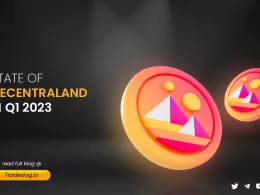Quick Links
Wormhole (W) is a protocol designed to enable cross-chain interactions. It serves as a bridge, allowing seamless communication and transfer of assets between different blockchain networks. In a market where interoperability has been a significant challenge, Wormhole’s relevance cannot be overstated. It holds the potential to unlock new levels of connectivity between diverse blockchain ecosystems, thereby fostering a more integrated and functional global blockchain infrastructure.
What is Wormhole?
In a more technical sense, a wormhole is a solution to the equations of Einstein’s theory of general relativity. It connects two distant points in space or time via a tunnel. The length of this tunnel is ideally shorter than the distance between those two points, making the Wormhole a kind of shortcut. This concept of a wormhole in physics has been applied to blockchain technology. In the blockchain context, the “distant points” can be thought of as different blockchain networks that are unable to communicate with each other directly. The “tunnel” is the Wormhole protocol that enables these networks to interact.
The purpose of Wormhole is to solve the problem of interoperability in the blockchain space. Interoperability, or the ability of different systems to work together, is a significant challenge in blockchain technology. Different blockchain networks often operate in isolation because they have different protocols and standards. Wormhole addresses this issue by allowing different networks to communicate and share assets, thereby making the entire blockchain ecosystem more integrated and functional.
When a transaction is made from one blockchain network to another using Wormhole, the protocol locks the original asset on the source network. It issues a corresponding asset on the target network. This ensures that the total supply of the asset remains constant across all networks. When the asset is transferred back to the original network, the corresponding asset on the target network is burned (or destroyed), and the original asset on the source network is unlocked. This mechanism allows assets to move freely between different networks while maintaining their scarcity and value.
Wormhole Tokenomics
The tokenomics of Wormhole is important because it outlines how the W token will be distributed and used within the ecosystem.
Token Allocation
| Category | Total |
| Guardian nodes | 5.10% |
| Community & launch | 17.00% |
| Ecosystem & incubation | 31.00% |
| Core contributors | 12.00% |
| Strategic network participants | 11.60% |
| Foundation treasury | 23.30% |
| Total | 100.00% |
Token Distribution & Release Schedule
- The maximum supply of W is 10,000,000,000
- The initial circulating supply is 1,800,000,000
- 82% of W are initially locked and will unlock over the course of four years
Use Cases
- Cross-Chain Asset Transfer: Wormhole enables seamless transfer of assets between different blockchain networks. This allows users to move their tokens across chains, expanding their reach and usability.
- Multi-Chain DApps: With Wormhole, developers can build decentralized applications (DApps) that work across multiple chains. This means users can interact with these DApps from any supported blockchain network, thereby increasing the DApp’s user base.
- Cross-Chain NFT Collection: Wormhole allows users to take their NFT collections cross-chain. This means users can move their NFTs between different blockchain networks, enhancing their accessibility and marketability.
- DeFi Applications: Wormhole can be used to facilitate decentralized finance (DeFi) applications. For example, Hashflow, a multi-chain DEX aggregator, uses Wormhole to enable users to seamlessly swap their assets natively across multiple chains. This provides users with better prices, lower network fees, and a more efficient trading experience.
- Data Access: Wormhole can provide on-demand access to on-chain data. This can help developers build more robust and data-driven applications.
- Governance: Wormhole can be used to facilitate cross-chain governance. This allows decentralized organizations to operate across multiple blockchains.
- Payments: Wormhole can enable cross-chain payments. This means users can make payments on one blockchain using assets from another.
- Liquidity Provision: Wormhole can help provide liquidity across multiple chains. This can benefit decentralized exchanges and other DeFi platforms.
Case Studies
Uniswap
Uniswap, a popular decentralized trading protocol, uses Wormhole for all its cross-chain deployments. This decision was made after an extensive evaluation by the Uniswap Bridge Assessment Committee. The integration with Wormhole has allowed Uniswap to facilitate seamless, native-to-native cross-chain swaps at the best prices and provide a significant reduction in network fees.
Pike
Pike is a Universal Liquidity Protocol that uses Wormhole to aggregate liquidity across blockchains. By integrating Wormhole Messaging and leveraging Circle’s Cross-Chain Transfer Protocol (CCTP) for native USDC bridging, Pike can abstract away all the complexity of building a natively multichain application. Wormhole’s out-of-the-box solution for multichain interoperability facilitates the verification of collateral and borrowing positions regardless of network, resulting in both a highly secure and seamless user experience.
Hashflow
Hashflow is a multichain DEX aggregator that uses Wormhole to enable users to swap their assets seamlessly across multiple chains. This includes Ethereum, Arbitrum, Avalanche, BNB Chain, Optimism, Polygon, and Solana. The integration with Wormhole has allowed Hashflow to facilitate seamless, native-to-native cross-chain swaps at the best prices and provide a significant reduction in network fees.
Threshold
Threshold uses Wormhole to take Bitcoin cross-chain in a decentralized way. Many people bridge Bitcoin to Ethereum, but doing so requires sending their Bitcoin to an intermediary in exchange for an ERC-20 token that represents the original asset. This centralized model requires you to trust a third party and is susceptible to censorship. To solve this problem, Threshold uses Wormhole to create a decentralized wrapped Bitcoin asset (tBTC) that enables holders to unlock their Bitcoin’s value to borrow and lend, mint stablecoins, and provide liquidity without having to trust centralized intermediaries.
Conclusion
The increasing fragmentation of the blockchain space means that the demand for interoperability solutions like Wormhole is likely to rise. Moreover, as more developers and users recognize the benefits of cross-chain interactions, Wormhole’s user base could expand rapidly.
Furthermore, the diverse use cases of Wormhole, from cross-chain asset transfers to multi-chain DApps, indicate its potential to become a key infrastructure component of the global blockchain ecosystem. However, like any technology, Wormhole’s success will depend on various factors, including market adoption, regulatory developments, and technological advancements. But given its innovative technology and unique value proposition, Wormhole has a promising future ahead.









